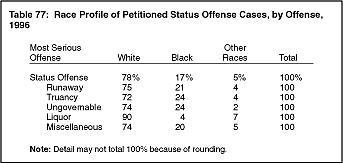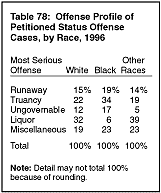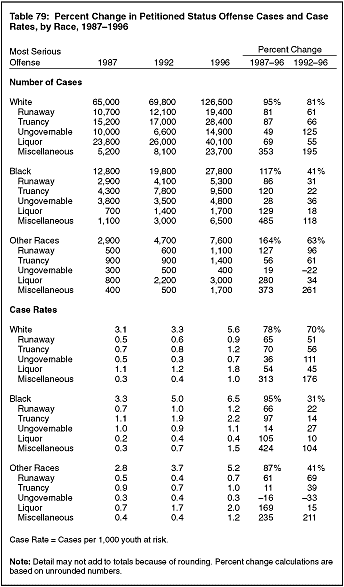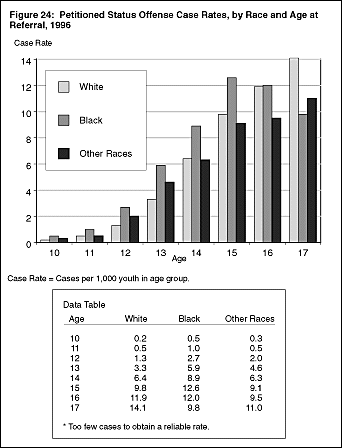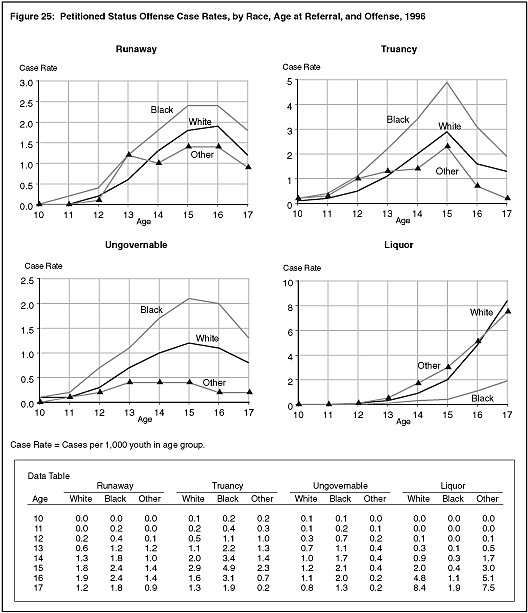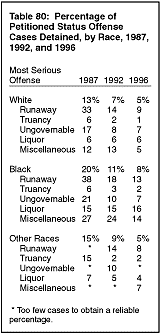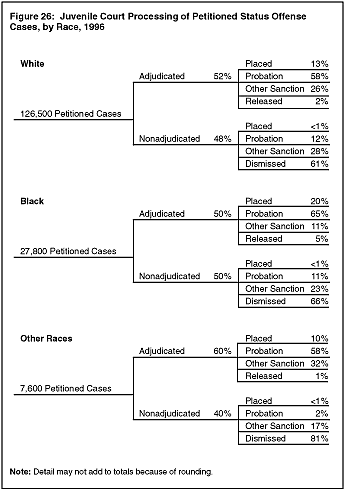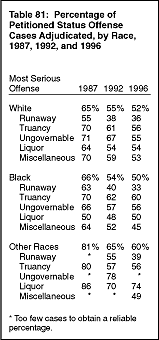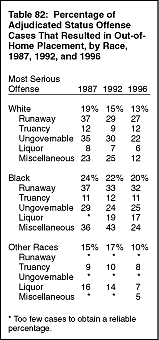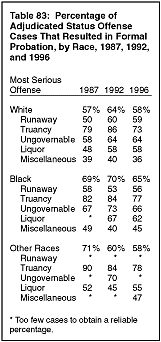|
In 1996, white juveniles were involved in a substantial majority of all formally processed status offense cases (78%), a proportion comparable to their representation in the general population (table 77).11 White youth were involved in 90% of status liquor law violation cases, 75% of runaway cases, 74% of ungovernability cases, and 72% of truancy cases. Compared with black youth, white youth and youth of other races had greater proportions of status liquor law violations and smaller proportions of truancy cases (table 78).
Between 1987 and 1996, the number of petitioned status offense cases increased 95% for white youth, 117% for blacks, and 164% for youth of other races (table 79). Increases occurred in all offense categories for all races, with white juveniles having the largest increase in truancy cases, and black youth and youth of other races the largest increase in liquor law violation cases.
In 1996, the total status offense case rate for black juveniles (6.5 cases per 1,000 black youth in the juvenile population) was greater than the rates for white youth (5.6) and for youth of other races (5.2). In all offense categories except liquor violations, case rates for black youth were greater than corresponding rates for whites or for youth of other races. The case rate for liquor law violations, on the other hand, was lowest among black juveniles: 0.4, compared with 1.8 for white youth and 2.0 for youth of other races.
The overall status offense case rate for white juveniles increased continuously with age in 1996, rising from 3.3 for 13-year-olds to 14.1 for 17-year-olds (figure 24). Compared with case rates for whites, rates for black youth were higher through age 15, nearly equal at age 16, and lower at age 17. Case rates for black youth increased through age 15 and then dropped. For youth of other races, case rates peaked at age 17.
For runaway, truancy, and ungovernability offenses, case rates among all racial groups peaked at age 15 or 16, then dropped (figure 25). In contrast, case rates for status liquor law violations increased continuously through age 17 among all racial groups.
Detention
In 1996, detention was used at some point between referral and disposition in 5% of all petitioned status offense cases involving white youth, 8% of those involving black youth, and 5% of those involving youth of other races (table 80). Black youth were more likely than white youth or youth of other races to be detained in cases involving runaway and liquor law violations. Between 1987 and 1996, the use of detention for petitioned status offense cases declined substantially among all racial groups.
Judicial Decision and Disposition
Petitioned status offense cases involving white youth and black youth were less likely to be adjudicated than were cases involving youth of other races in 1996 (figure 26). Adjudication resulted in 52% of cases involving white youth, 50% of those involving black youth, and 60% of those involving youth of other races. Adjudicated cases involving black youth were less likely than those involving white youth or youth of other races to receive a disposition of "other," possibly as a result of the relatively low volume of liquor violation cases among blacks.
In 1996, the overall likelihood of adjudication was comparable for all races in all offense categories, with one exception: for status liquor law violations, adjudication was less likely for white youth (54%) and black youth (50%) than for youth of other races (74%) (table 81).
Once adjudicated, status offense cases involving black youth were more likely to result in out-of-home placement than were cases involving white youth or youth of other races (table 82). In 1996, out-of-home placement was used in 20% of adjudicated cases involving black youth, 13% of those involving whites, and 10% of those involving youth of other races. Out-of-home placement in liquor law cases was more likely for blacks (17%) than for whites (6%) and other races (7%). Placement in truancy cases was more likely for whites (11%) and blacks (12%) than for other races (8%). For ungovernability cases, the likelihood of out-of-home placement was about the same for white youth (22%) and black youth (25%). Between 1987 and 1996, the probability of out-of-home placement decreased for youth of all races.
In 1996, probation was the most restrictive disposition used in 65% of adjudicated status offense cases involving black youth and 58% of cases involving whites or youth of other races (table 83). In all racial groups, probation was most likely for truancy cases. Between 1987 and 1996, the likelihood of formal probation increased slightly for cases involving white youth (from 57% to 58%), and decreased for cases involving black youth (from 69% to 65%) and youth of other races (from 71% to 58%).
|
